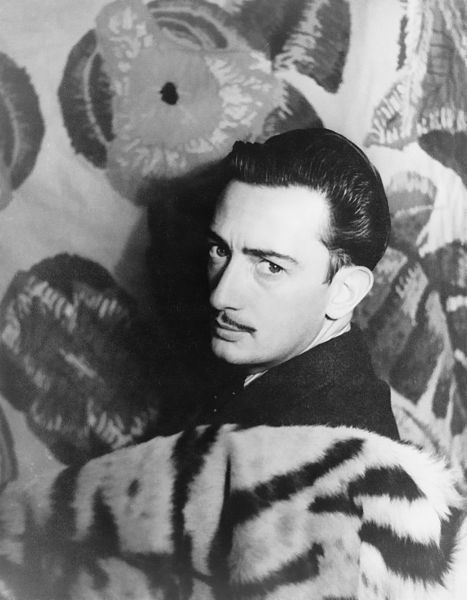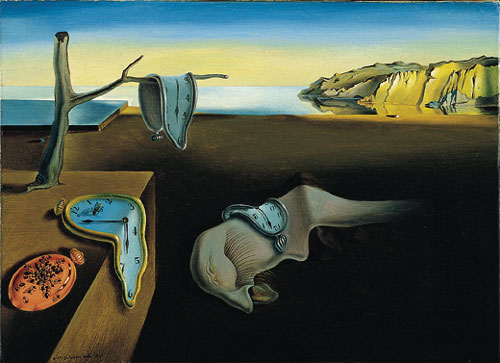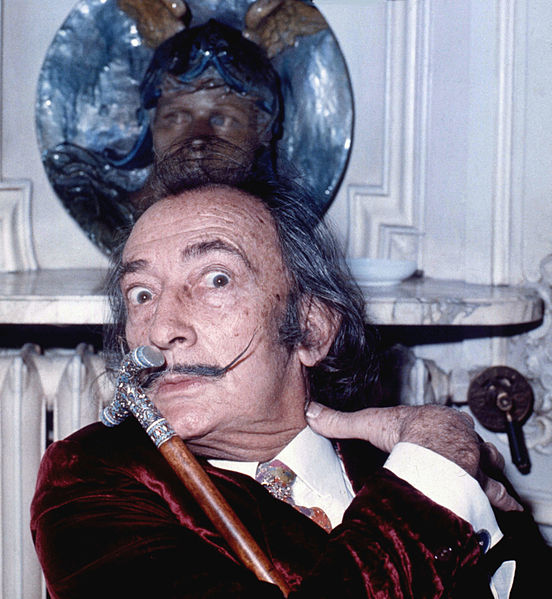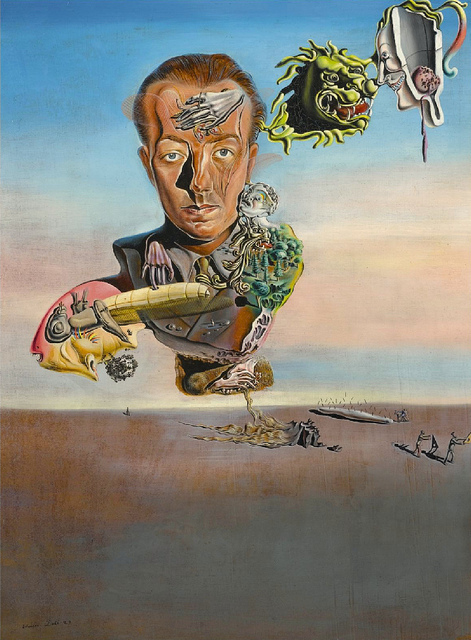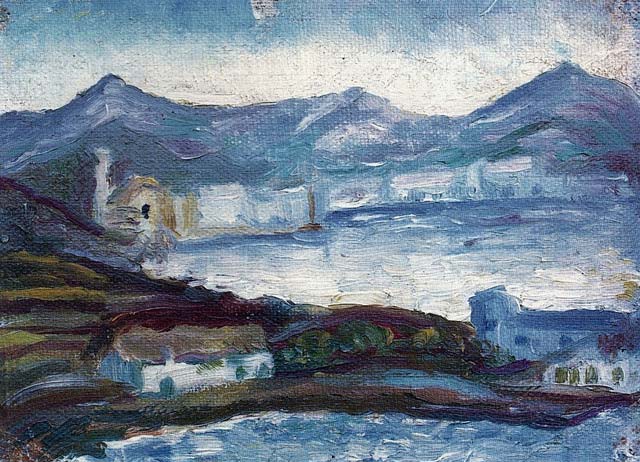| Famous Paintings by Salvador Dalí | |
| The Persistence of Memory, 1931 | |
| The Disintegration of the Persistence of Memory, 1952-1954 | |
| The Face of War, 1940 | |
| The Ecumenical Council, 1960 | |
| Landscape Near Figueras, 1910 | |
| Christ of Saint John of the Cross, 1951 | |
| Lobster Telephone, 1936 | |
| Swans Reflecting Elephants, 1937 | |
| Apparatus and Hand, 1927 | |
| The Discovery of America by Christopher Columbus, 1959 | |
| Morphological Echo, 1934-36 | |
| The First Days of Spring, 1929 |
Salvador Dalí was one of the most eccentric artists ever. He dubbed a spectacular handle bar mustache, beginning in the 1920’s, and is best known for his achievements in Surrealism Art. He used many methods to reflect his ideas, including paint, charcoal, film, and sculpture, all which were amusing and avant garde in their time.
Born on May 11, 1904, Dalí was told from the beginning that he was a reincarnation of his brother who had died nine months before he was born. His parents told him this often, and he was named after his dead brother. Throughout his life, he often reflected upon this, and he believed it himself. His artistic ambitions were encouraged from a young age, and he attended a drawing school on his youth. In 1919, at the age of 14, Dalí’s dad held an exhibition in their house for him.
In February of 1921, his mom died of breast cancer, and he was deeply hurt. Soon after, Salvador’s dad married his aunt, who was his mom’s sister who had been widowed some years before. Dalí was fine with the marriage, for he loved his aunt and welcomed her to be his new mom.
The next year he attended Academia de San Fernando for four years. Here he learned his technique and skills for all the other mixed medias he was going to use in the future. But, before the final exams were over, Dalí was expelled, for he had proclaimed that no teacher was competent enough to examine him. He left Spain, and went to Paris. There, he met Picasso, who had been his biggest influence up to then. To his surprise, Picasso had already heard of him through another artist, Joan Miró, and that he had spoke favorably of him.
Besides Picasso, Dalí was influenced by Raphael, a Renaissance artist, Vermeer, a Dutch Baroque artist, and Velazquez, a Spanish Baroque artist. His work does not reflect their influence on him too much, but those were the artists he appreciated most.
In 1929, he met Luis Buñuel. Together, they made and produced a movie called Un Chien Andalou. It was 17 minutes long, and it incorporated all the Surrealists ideals. In it, ants come out of a watch, which later he painted in his painting, the Persistence of Memory. It is black and white, and in the beginning of the film, a boy on a bicycle is hit by a car, and ants start coming out from his hand. The film has no plot, and is suppose to make the viewer seem like they are dreaming. On the set of making this short film, he met Gala, a Russian immigrant whom he fell in love with. She was eleven years older than him, and she was married to a Surrealist poet at the time. His father disapproved of her and her connection with the Surrealists.
In 1930, Dalí exhibited in Paris a work with a surrealist exhibit of the “Sacred Heart of Jesus Christ.” Underneath the drawing, it said, “sometimes, I spit on my mother’s portrait just for fun.” His father begged him to apologize for the rude comment, and when Dalí refused, his father disinherited him.
The next year, he came out with The Persistence of Memory, which is considered his best work. In the painting, pocket watches melt on braches and counter tops. Another watch has ants spewing out, reminiscent of the movie. On the right, half a face is laying on the ground, which is another image that Dalí uses in several of his paintings. The image is usually interpreted as representing Einstein’s theory on time, since the theory had been written and printed around that time.
In 1934, Dalí finally married Gala, his girlfriend of five years. Since his first exhibit in America was after their wedding, they decided to travel there. They hosted a ball, and dressed up as the kidnapped Lindbergh baby and its kidnapper and were severely criticized for doing so. They were forced to apologize, and left America right afterwards.
Two years later, Dalí met Edward James, who became his new patron. He commissioned several works of art that resembled the Dada era. For instance, the Lobster Telephone. A person would talk into the lobster’s genitals, and listen through the head. Another piece was Mea West Lips Sofa. Dalí had a fascination with her lips, so he made them into a couch.
When World War II began, he and Gala moved to America to avoid the war. They had been living in France at the time, and when the Germans threatened to invade, they got out. Many of the Surrealists were mad at Dalí for leaving. Dalí believed that artists shouldn’t exclaim their views on politics, but the rest accused him of being a Hitler supporter for not having publically declared a side.
He wrote an autobiography while in America, called The Secret Life of Salvador Dalí. He also continued painting, but none of it reached the popularity it had before the war. In 1949, he moved to Catalonia, Spain, which made the other Surrealists even more infuriated, because it was under the dictatorship of Francisco Franco, and he still hadn’t chosen a side. He was soon expelled from the group.
In 1960, he built the Dalí Theater and Museum in Figures, Spain, where he had been born. He and Gala lived above it, and held auditions for the stage actors. But in 1980, Dalí’s health deteriorated. Gala had been giving him some medicine that wasn’t prescribed by his doctor, and it ruined his nervous system, leaving him with Parkinson’s like symptoms which prevented him from painting.
In 1982, Franco was out of power, and a King was on the throne again. King Juan Carlos gave Dalí the title of Marqués de Dalí de Púbol. The King’s favorite artist was Dalí, and Dalí gave him the last drawing he ever made. Gala died later that year, and he was deeply depressed. Dalí lost all will to live, and attempted suicide by dehydrating himself. He was moved to his castle in Púbol, which he had built for Gala, and a fire started in his room. He was rescued, but it was always believed to have been started by Dalí as another attempt at suicide. In November 1988, Dalí was taken to the hospital for heart failure. He suffered there for three months, and on January 23, 1989, Dalí died, with King Juan Carlos by his side.
